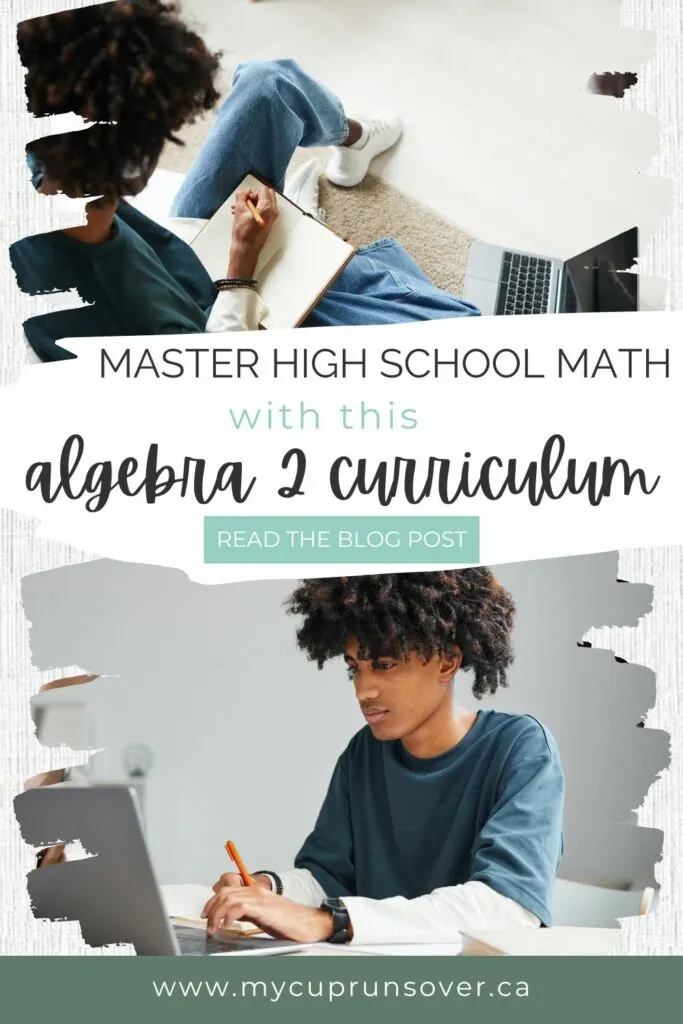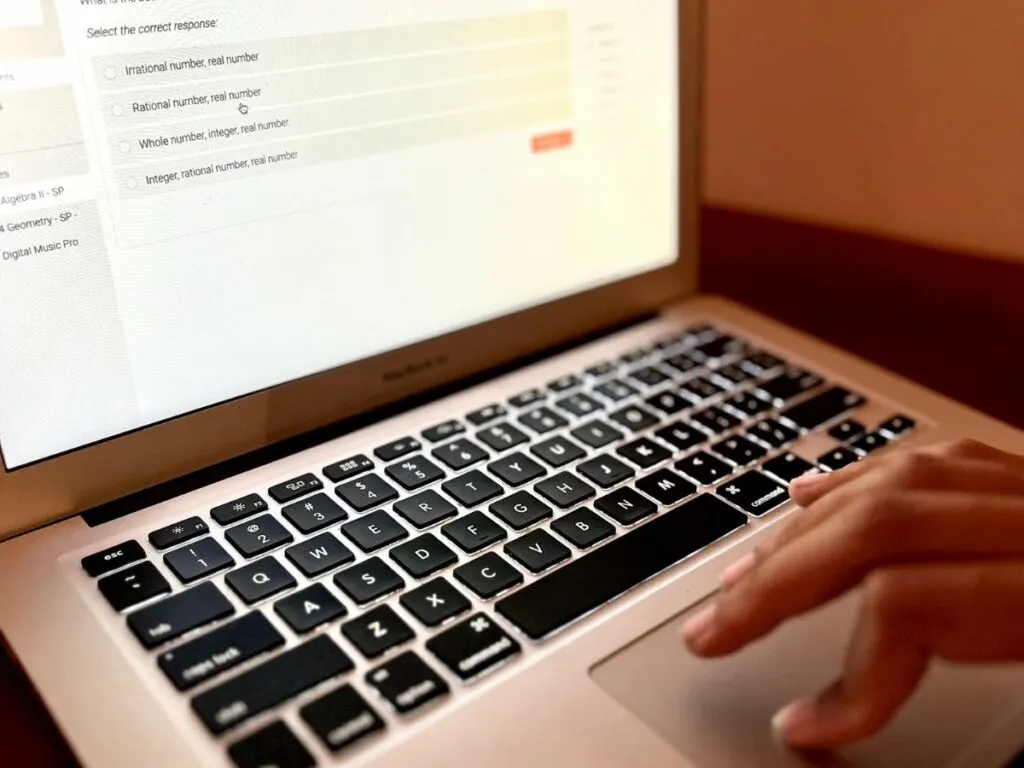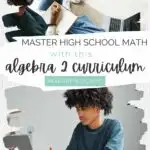Whether you’re teaching math in your homeschool or looking for an Algebra 2 curriculum to supplement what your child is learning at school, Mr D Math’s self-paced Algebra 2 class is an excellent option. In this post, I’ll cover Mr D Math’s approach to teaching, the content of the Algebra 2 course, and why our family uses Mr D Math exclusively for teaching middle school and high school math.

I received access to Mr D Math’s Algebra 2 course for review purposes and I was compensated for my time. All opinions are my own and I am not required to post a positive review.
Why We Chose Mr D Math for High School Algebra II
Before we switched to Mr D Math several years ago, my kids struggled with math a lot. As a math nerd myself, I was distraught at my inability to pass my love of numbers on to my children.
I made the false assumption that loving math would make me a good teacher of math.
Unfortunately, my ease with the more complex topics like algebra made it hard for me to connect with my kids’ struggles and help them work through them.
But as soon as we switched to Mr D Math—we started with pre-algebra, an introductory middle school math course—things started to click for them. They adapted well to the lesson formats and rarely complained about having to do their math.

I won’t go so far as to say they developed a love of math, but they overcame their fears and made their peace with it.
My eldest daughter stuck with Mr D Math all the way through and finished high school math before 11th grade. Her younger sister is now taking Algebra 2 in grade nine and is set to finish early as well.
Mr D Math’s classes made our lives significantly easier and helped us develop a greater appreciation for one of our toughest subjects. Not only that, but our kids have the foundation they’ll need if they choose to take a higher-level math course in the future.
We are completely committed to continuing on with his math classes and whatever other courses he puts out on his site (check out my review of the Digital Music Production course).
Finding a Math Curriculum that Works for Your Family
Finding a math curriculum that works for your family can take a bit of detective work. Whether you’ve been developing your own curriculum up to this point or you’re switching over from another company, it’s important to take some time to discern what you and your kids need in a curriculum.
I find it’s key to think about how my kids learn best. I observe them to see whether they absorb information best visually, aurally, or kinesthetically. If they are hands-on learners who need a bunch of physical manipulatives, Mr D might not be the best fit.
On the other hand, if they enjoy learning by watching videos where someone demonstrates how to do problems and then walks them through several different types of problems while they complete their homework, it’s likely to be a hit.
I learn well in this way and it turns out my kids mostly do too, so the program was a strong match for us, but for some kids, the level of focus required for this method is too much.
Do your kids need to write things down to process them? Mr D Math is perfect for learners who like to have everything written out step-by-step. His approach is very methodical and he encourages students to develop the same type of discipline he applies to each question.

Depending on how much accountability and structure kids need, they may gravitate more toward the self-paced or online math classes. The self-paced course is perfect for independent learners who want to get their work done without waiting on anyone else, but live online math classes are better suited for students who need a more interactive experience with lots of structure.
If you have an honors student in your family, Mr D Math can also be a great option for them as there is an optional honors assignment within each chapter so they can extend their learning further.
Mr. D’s Approach to Teaching Math
One of the reasons I think Mr. D’s teaching style resonates so well with me is that it reminds me of one of my favorite teachers, who taught me in grades four and five and was a huge factor in my love of math. They both possess a thoughtful approach that helps students deepen their conceptual understanding of key topics rather than just memorizing a whack of math facts in order to pass a final exam.
At the heart of Mr. D’s approach is the belief that kids should play an active role in their own learning. Rather than having a linear process where the teacher explains a topic, the student does the assignment, the teacher marks it, and everyone moves on, Mr. D takes a more integrative approach.
He believes students learn more when they mark their own work and get a chance to correct mistakes they’ve learned. By applying their newfound knowledge to the same questions they’ve already done, they cement the pathways in their brain that allow the knowledge to become permanent.

Students can watch the lesson video multiple times until they understand the concept. He even encourages them to watch it as they’re doing the assignments. Instead of pushing students to immediately memorize what’s being taught, he allows them to explore it in different ways until it becomes their own.
Students are then given answer keys and tasked with marking their own assignments and recording their grades. Doing so allows them to see and fix their own mistakes so they don’t make the same ones again.
By helping them take responsibility for their own learning, he removes much of the pressure that surrounds traditional math classes so that deep learning can take place.
Mr D Math Algebra II Curriculum Content
Below is an overview of all the topics you can expect to find in the Algebra 2 course from Mr D Math.
But first, if you have never taken one of his self-paced math programs before, here’s a quick rundown on the flow of the course. Each class has twelve chapters. A semester exam is offered at the end of every six chapters and students write a chapter test for each chapter.
Chapters are comprised of between five and eight lessons. Each of these features a video tutorial, at least one assignment, and a quiz. Every few lessons, you’ll also find a spiral review to reinforce previously covered concepts.
Here is the complete list of topics Mr. D teaches in Algebra 1:
Chapter 1 – Equations and Inequalities
- Real Numbers
- PEMDAS and Expressions
- Solving Equations
- Solving Literal Equations
- Absolute Value
- Inequalities
- Compound Inequalities
- Word Problems
Chapter 2 – Linear Relations and Functions
- Standard Form and Intercepts
- Three Forms of Slope
- Writing Linear Equations
- Scatter Plots and Lines of Regression
- Piecewise Functions
- Parent Functions and Transformations
- Graphing Inequalities
- Linear Word Problems
- Linear Functions and Systems of Linear Equations
Chapter 3 – Systems of Equations and Inequalities
- Solving Systems by Graphing
- Solving Systems by Substitution and Elimination
- Solving 3 Variable Systems
- Solving Systems of Linear Inequalities
- Linear Programming
Chapter 4 – Matrices
- Introduction to Matrices
- Matrix Addition and Subtraction
- Matrix Multiplication
- Determinants
- Solving Systems with Matrices
Chapter 5 – Quadratic Functions and Relations
- Quadratic Equations and Their Graphs
- Solving Quadratic Equations by Graphing
- Solving Quadratic Equations by Factoring
- Complex Numbers
- Completing the Square
- Solving Quadratic Equations with the Quadratic Formula
- Vertex Form of a Parabola
- Solving Quadratic Inequalities
Chapter 6 – Polynomial Functions and Relations
- Properties of Exponents
- Operations with Polynomials
- Working with Function Notation and End Behaviors
- Real Zeros, Relative Maximums and Minimums
- Factoring Cubes and Beyond
- Rational Zeros
- Writing Polynomial Functions
Chapter 7 – Inverse and Radical Functions and Relations
- Composite of Functions
- Inverse Relations and Functions
- Radical Domains
- Simplifying Radicals
- Operations with Radicals
- Rational Exponents
- Solving Radical Equations and Inequalities
- Radical Expressions
Chapter 8 – Exponential and Logarithmic Functions and Relations
- Exponential Growth and Decay
- Exponential Equations and Compound Interest
- Exponential Functions
- Exponential Expressions
- Logarithms
- Solving Logarithmic Equations
- Properties of Logarithms
- Solving Equations Using Logarithms
- Natural Base e and Natural Log
- Continuous Growth and Decay
Chapter 9 – Rational Functions and Relations
- Rational Numbers
- Multiplying and Dividing Rational Expressions
- Adding and Subtracting Rational Expressions
- Graphing Rational Expressions
- Solving Rational Equations
- Direct and Inverse Variations
Chapter 10 – Conic Sections
- Midpoint and Distance
- Parabolas
- Circles
- Ellipses
- Hyperbolas
- Classifying Conic Sections
Chapter 11 – Sequences and Series
- Sequences and Series
- Arithmetic Sequences
- Arithmetic Series
- Geometric Sequences
- Geometric Series
- Infinite Geometric Series
Chapter 12 – Probability and Statistics
- Counting Principles
- Combinations and Permutations
- Applications of Combinations and Permutations
- Pascal’s Triangle
- Probability
Check Out Mr D Math’s Algebra 2 Curriculum
If you’re looking for a new self-paced or live online Algebra 2 class for your homeschool, I can’t recommend Mr D Math highly enough. He makes math accessible for students who’ve struggled with it their whole lives, helping them grasp complex concepts and master the content.
He also offers a 30-day money-back guarantee, so if you try the class and find out it’s not a good fit for your child, there’s nothing lost. You can just reach out to the support team and they’ll reimburse you.
Visit the course catalog today and find out how Algebra 2 and the many other classes offered will help your kids unlock their math potential.

Sophie Agbonkhese is a writer, homeschooling mother of four, and a recovering overachiever (who occasionally relapses). She is the founder of My Cup Runs Over, a site dedicated to helping busy women simplify and enrich their lives. When she’s not writing or debugging websites, Sophie spends her time reading, dancing, bullet journaling, reading, gardening, listening to audiobooks, and striving fruitlessly to have a clean house for at least five minutes.

